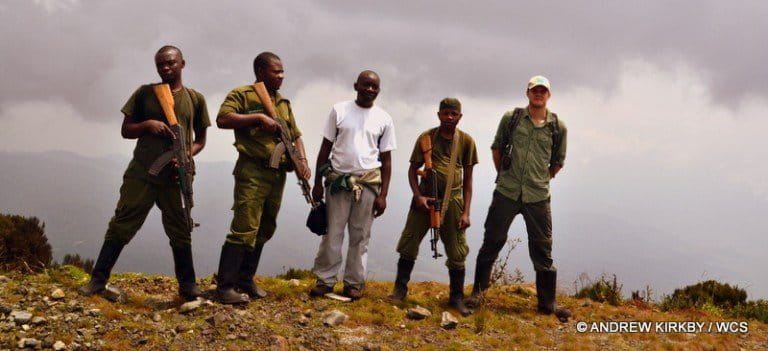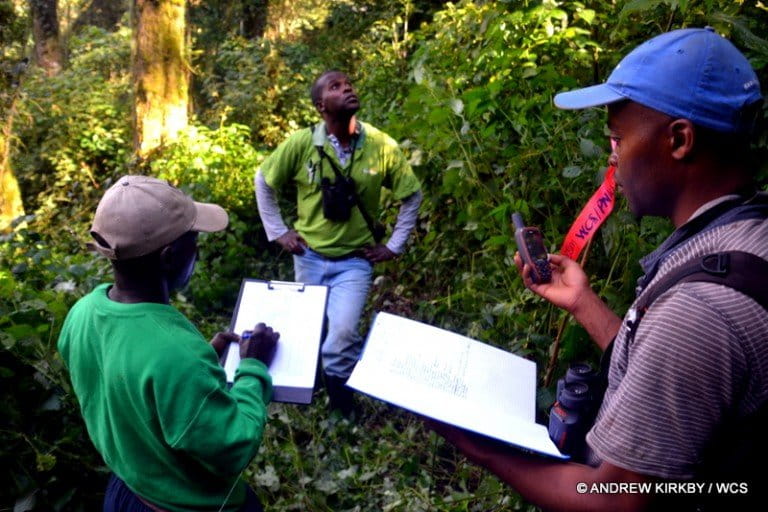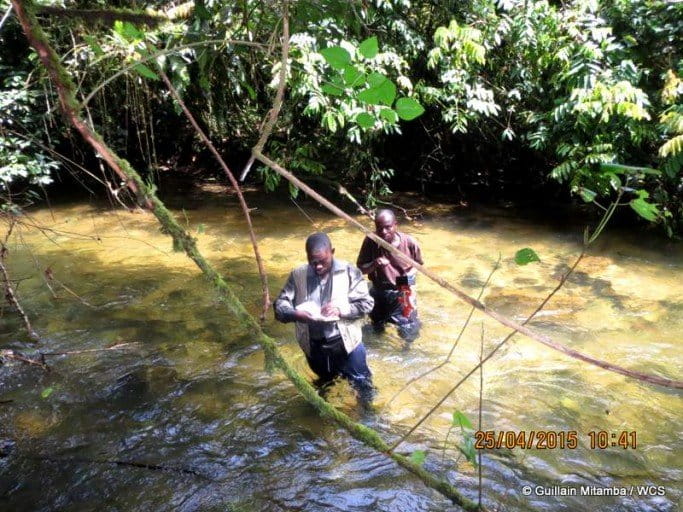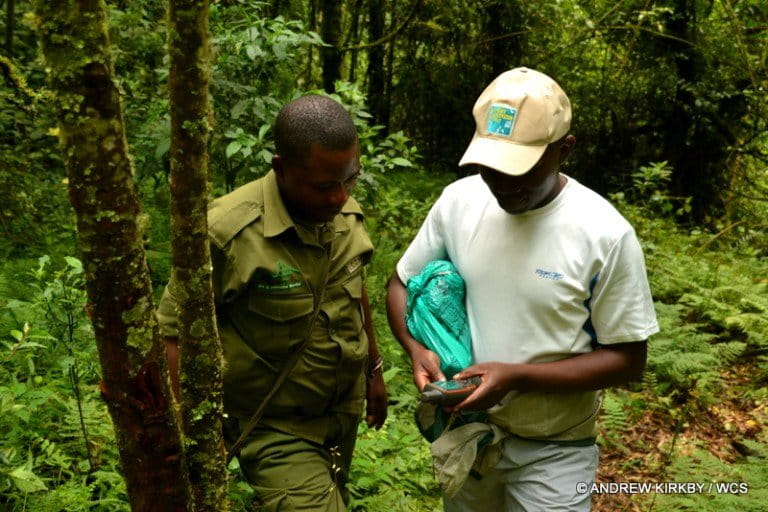- Grauer’s gorilla is the largest primate subspecies in the world, and lives only in eastern DRC.
- Mining, war, and poaching for bushmeat has taken a big toll on the gorillas, with recent surveys indicating a 77 percent decline in their numbers since 1995.
- Researchers who conducted the surveys urge raising the subspecies’ IUCN status to Critically Endangered and increasing protection through more effective government management of the embattled region.
For two decades, a devastating civil war in the Democratic Republic of the Congo (DRC) prevented scientists from monitoring Grauer’s gorillas (Gorilla beringei graueri). But now, data from recent surveys of Congolese forests have shown what conservationists feared — that the world’s largest primate subspecies has declined precipitously. The groups responsible for the research are recommending changing the gorilla’s IUCN conservation status from Endangered to Critically Endangered, and calling for stronger protection of its dwindling habitat.
The findings were published this week in a report by international conservation organizations Wildlife Conservation Society (WCS) and Fauna and Flora International (FFI).
Grauer’s gorilla, also called the eastern lowland gorilla, comprises one of two subspecies of the eastern gorilla (Gorilla beringei). It is distinct from its sister subspecies, the mountain gorilla (Gorilla beringei beringei), in its range and in its size. While mountain gorillas live in both the DRC and across the border in Uganda and Rwanda, Grauer’s gorillas are only found in the DRC. They’re also the largest gorilla subspecies, reaching up to 500 pounds (227 kilograms).
The fact that Grauer’s gorilla habitat is entirely within the DRC has been its downfall. Starting in 1996, the country was locked in a civil war that led to the deaths of millions of people. The war also had a devastating impact on wildlife and forests, leading to an upturn in the bushmeat trade and deforestation; the constant threat of violence barred scientific monitoring.
“It is one of the least known apes in terms of its ecology and population due to the existence of armed groups and very poor infrastructure to access gorilla sites,” said Andrew Kirkby, Project Manager for the WCS’s Grauer’s Gorilla Conservation Project, which provides financial and technical support to Kahuzi-Biega National Park and surrounding reserves in the eastern DRC.

The war ended in 2003, but armed groups are still scattered throughout the country. To avoid danger while getting an updated look at the Grauer’s gorilla population, WCS and FFI with the International Union for Conservation of Nature (IUCN) banded together with local community members and rangers to survey Congolese forests for signs of gorillas. These surveys were made possible through the funding of ARCUS Foundation, USAID, UNESCO, U.S. Fish and Wildlife Service, Newman’s Own Foundation and German bank KFW.
What they found was not promising. From an estimated 17,000 gorillas in 1995, approximately 3,800 exist today. The results are discussed in a report by WCS and FFI, which states this 77 percent decline (upwards of 93 percent in some places), is due to many factors including illegal hunting, civil unrest, and habitat loss from agricultural expansion. The study also found eastern chimpanzees had declined in the region by 22 to 45 percent.
The researchers write that one of the biggest threats to apes in the eastern DRC is artisanal mining for gold, coltan, cassiterite, and other minerals, which are often controlled by armed groups. These mines are generally deep inside the forest, forcing the miners to hunt gorillas and other animals for food.

The report states that the extent of the gorilla’s decline merits upgrading the IUCN conservation status of Grauer’s gorillas to Critically Endangered — a move that would afford the subspecies greater protection and attention.
“Grauer’s gorilla is found only in the eastern Congo – one of the richest areas on our planet for vertebrate diversity,” said Stuart Nixon of Fauna & Flora International and Chester Zoo, one of the co-authors involved in the study. “As one of our closest living relatives, we have a duty to protect this gorilla from extinction. Unless greater investment and effort is made, we face the very real threat that this incredible primate will disappear from many parts of its range in the next five years. It’s vital that we act fast.”
To help keep an eye on the remaining gorillas, WCS established SMART (Spatial Monitoring and Reporting Tool) databases across much of the eastern DRC including national parks and community reserves. Rangers and eco-guards now have the ability to collect data on illegal activities and record wildlife observations on their smartphones during patrols.
With the use of SMART technology and large-scale collaboration between organizations and local communities, conservationists say there is hope for gorillas and their surrounding habitat.

“In more remote areas, WCS is working with communities to develop community reserves as well as supporting ICCN to increase their effort to protect areas that have been less able to be protected in the past,” Kirkby said. “Engaging local communities has been seen as a big success for conservation as rangers are too few to protect the vast protected areas that exist.”
But for WCS and others working to conserve Grauer’s gorillas, there is still a long and arduous road ahead in saving this subspecies from extinction. One big step, they say, is encouraging the Congolese government and communities to increase protection of the great apes in reserves and national parks, and legally define protection for areas of gorilla habitat that aren’t yet under official protection. The authors of the report also urge greater management of artisanal mines in the DRC and disarmament of the militia groups that control them.
“We urge the Government of DRC to actively secure and manage this part of the country for both human welfare as well as the survival of this gorilla,” said the study’s lead author Andrew Plumptre of WCS. “Significantly greater efforts must be made for the government to regain control of this region of DRC. In particular, the Government needs to quickly establish Reserve des Gorilles de Punia and the Itombwe Reserve, and reinforce Kahuzi-Biega National Park efforts, which have community support, and to establish strong coordination between ICCN and the DRC military to tackle armed militias that control mining camps in Grauer’s gorilla heartland.”
Mongabay caught up with Kirkby about the new report on Grauer’s gorillas, how SMART works, and the challenges of doing conservation work in a country still rife with conflict.

An interview with Andrew Kirkby, Project Manager for WCS’s Grauer’s Gorilla Conservation Project:
Mongabay: What are the major threats the gorillas are facing?
Andrew Kirkby: The major threats to Grauer’s gorilla are illegal hunting of the species for bushmeat, particularly around mining concessions that are often deep in the forests. Civil wars have also left a lot of fire arms in the east of the country which are often used to hunt. Other reasons include habitat loss due to agriculture and roads development through the forest as well as trafficking of live apes and the risk of transmission of disease.
Mongabay: What can be done to help Grauer’s gorilla numbers stabilize?
Andrew Kirkby: WCS and ICCN recent gorilla surveys in 2015 of Kahuzi-Biega National Park’s tourism sector of Tshivanga has shown a 47 percent increase in gorilla populations over the last fourteen years. This success has been attributed to gorilla families that are regularly monitored as well as higher numbers of ranger patrols and veterinarians available in case of emergencies (mostly due to bushmeat snares). This type of intense system as found in other national parks such as Bwindi National Park in Uganda and Volcanoes National Park in Rwanda has proven to work, however, it is not possible everywhere, especially in remote and insecure areas.
Community leaders still hold a lot of influence and working with them and the community for conservation has seen a reduction of great ape hunting in some areas as well as community members calling in ICCN to confiscate live gorillas that are being attempted to be trafficked.


Mongabay: How do you plan on training eco-guards to patrol forests in the short-term as an “act fast” approach and what are the long-term solutions for saving Grauer’s gorillas?
Andrew Kirkby: Over the last two years WCS has already established fully functioning ranger based monitoring systems using SMART to help protected area managers better target ranger patrols. Rangers are often too few and lack basic supplies, logistics or training to adequately protect the huge protected areas that exist in the DRC. Continuing to build up ranger teams’ capacity and efficiency is a major step forward to protecting gorillas in the region.
Mid- to long-term solutions would need to include a mixture of interventions, some of these include: 1) regulation of artisanal mining sites, especially in national parks where they should not exist, 2) aiding community reserves to halt bushmeat consumption while developing alternative food sources that villagers could also sell to help meet local demand, 3) supporting the development and management of new community reserves, 4) increasing public awareness of conservation in local communities, 5) working with traditional chiefs and leaders to reinforce existing taboos around the hunting and consumption of great apes, 6) working to get governmental agencies to coordinate in tackling wildlife crime, 7) working to maintain habitat connectivity and 8) improving security and increasing available funding to enable conservation activities in key gorilla areas.
Mongabay: What role do Grauer’s gorillas play in their surrounding habitat? If conservation action is unsuccessful, how would the loss of this subspecies impact the ecosystem? And what would it mean for the eastern gorilla species as a whole?
Andrew Kirkby: As mentioned earlier, few studies have targeted Grauer’s gorillas compared to other subspecies. However gorillas are the mega-fauna of the eastern DRC and are important in the natural dynamics of the forests by clearing and opening up vegetation maintaining a healthy and functioning habitat as well as acting as seed dispersers. Gorillas are thought to have split from other great apes between eight and twelve million years ago with eastern and western gorilla species splitting around one and three million years ago. Overall they have existed in these areas a long time, to lose them in a generation would be devastating.
Despite the ecological significance of the species they also carry a strong cultural and economic importance – gorillas are an iconic species and taboo to hunt or eat in some communities. Like Rwanda which has seen huge economic development from tourism and as a result stronger conservation focus. Kahuzi-Biega National Park used to receive over 3,000 tourists a year before civil war broke out, and although greatly reduced, it still holds that potential.


Mongabay: Trying to work in politically sensitive and war-threatened areas is one of conservation’s many challenges. How do you begin to engage communities facing extremely dangerous levels of civil unrest? What do WCS and FFI factor in when deciding whether or not it is safe to conduct forest patrols and species monitoring/wildlife surveys in places with known conflicts?
Andrew Kirkby: The eastern DRC has been through historical and ongoing conflict and as conservation organizations come in, one of WCS’s rules of engagement when conducting any conservation activity is to ensure that it does not exasperate existing tensions and promotes peace building and cooperation between communities and wildlife conservation bodies – or what has been called a Conflict Sensitive Conservation approach (www.csconservation.org). This is an approach that WCS has been working with the International Institute for Sustainable Development (IISD), developing training programs and manuals for practitioners.
It is for this reason we are grateful to have teams trained and experienced in both wildlife surveys and CSC approaches. Before any teams are sent to do surveys we hold discussions with local leaders and key stakeholders so there is a clear understanding and permission to conduct surveys within a specified zone. On top of this we conduct a security prospection. In areas with ongoing conflict or where the Congolese army (FARDC) are carrying out missions for disbarment of local militias for example, we wait until security improves before our teams can go in. Despite preparing everything properly, security situations can be fluid and rapidly change so we always have local guides who know the forest and local context, keep updated security situation on the ground, satellite phones communicating with teams outside the forest and experienced team leaders to guide and make decisions in emergencies.


Mongabay: Much of the DRC has been allotted for mining concessions. Have you seen any mining activity taking place? How may this affect gorillas and other wildlife? What, if anything, is being done to counter the potential threats of mining?
Andrew Kirkby: Artisanal exploitation zones (AEZ) are easy to apply for in the DRC, miners can pay $10 for a permit, valid for one year. Unfortunately, the sector continues to be scrutinized due to the lack of law enforcement and its links to armed groups. It is a serious problem and can risk the lives of rangers. In fact during our latest surveys in Kahuzi-Biega National Park in December 2015, our survey teams came across an illegal mining camp guarded by rebel group called Nyatura. Our teams were fired upon and ICCN rangers managed to counter the attack and arrest miners without any casualties.
WCS’s study on mining around protected areas in the eastern DRC in 2015 found that bushmeat hunting occurred at almost all mine sites and nearly all participants openly stated that they consumed bushmeat. Mines were often isolated, but often draw in larger numbers of people creating micro-economies with huge demands for meat. Many sites had reported the disappearance of great apes due to hunting in recent years.
The ultimate aim is for mining in the region is to be “conflict free” – following equitable rule of law, eliminating human rights abuses, respecting indigenous rights, land rights, freedom of information and conserving the environment and biodiversity. Working to build the support for the demilitarization of mines, particularly those that are within and around the edge of protected areas is a major first step. It would not only improve security, but allow rangers to conduct patrols to protect remaining gorilla populations. Still the issue remains that even if mines are conflict free and legal, how to ensure that hunting originating from mine sites do not target endangered species or even cause the depletion of fauna from the surrounding forests as witnessed in the area.


